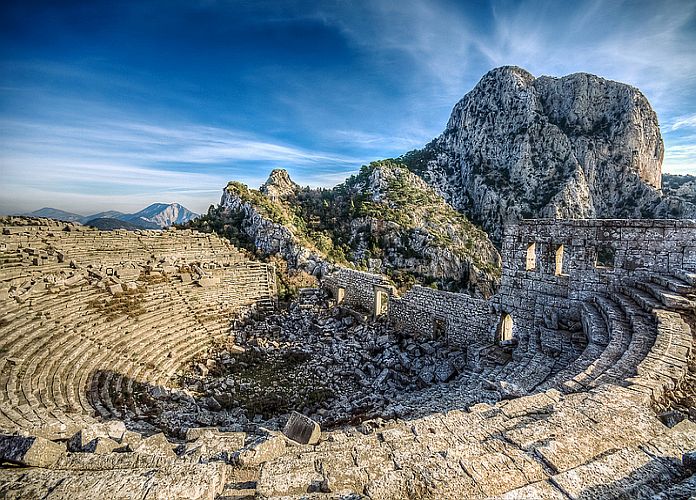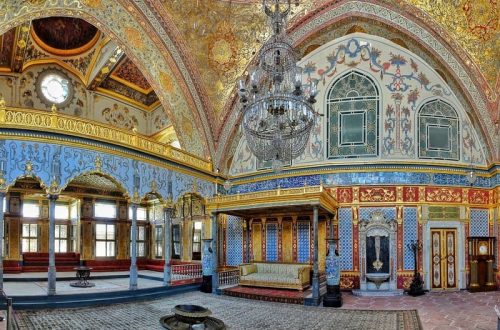
The ruins of Termessos
The ruins of Termessos: See the “Machu Pichu” of Turkey
Termessos, the fortress city in the Taurus Mountains, is, in my humble opinion, one of the most beautiful ancient cities in Turkey.
Solymer – that is how Homer called the inhabitants of Termessos in his famous classic, the Iliad – the story of Troy. The Termessos warriors had a special reputation.
The fortress city of Termessos is said to have been impregnable. In fact, nobody succeeded, not even Alexander the Great, the Persians or the Romans.
Termessos: The impregnable fortress city in the Taurus Mountains
Impregnable? This is due to the unique location of Termessos, high up in the Taurus Mountains, at the foot of Mount Solymos. There the “old stones” of the ruins are distributed at an altitude of 1,050 m 1,600 m near Antalya.
Almost insurmountable fortress walls kept enemies out on the steep mountain slopes of Solymos. There is still a lot to see in the ruins of Termessos.
I’ll show you the ruins of Termessos in many pictures and share some tips for a trip to the ruins in the Taurus Mountains.
Homer already mentioned there in his Iliad. It is therefore clear that the city below Mount Solymos is at least 2,800 years old. But what else is there to see in this unique city? And why do I call Termessos the Machu Pichu of Turkey?
Machu Pichu – the name is primarily related to the view from the 5,000 seat theatre of Termessos. It stands on a steep mountain slope in the upper part of the Termessos ruins.
Photos give an idea of what it must have been like in those days to be part of a performance in the theatre in Termessos. Imagine, sitting in the ampitheatre, far up in the mountains. A fresh breeze blows near your face, just as it blows through the ruins today. In addition, there is the unique, breathtaking view of the Taurus mountains.
The special location in the Taurus Mountains makes this place something special compared to other archaeological sites. Its secluded in the mountains and so far, there have hardly been any excavations in Termessos.
The seclusion and the few excavations are due to the tricky location of Termessos. To get to the ruins, you first have to drive 25 kilometres from Antalya to the entrance of the Termessos National Park.
At the entrance of the national park an eight kilometre winding road leads into the Taurus Mountains up to the lower part of the ruins. From there, you must walk another 30 to 45 minutes to the Termessos theatre.
Seeing Termessos is a combination of history, nature and hiking
The mountain road to this place leads steeply up the mountain. Next to the road are old fortifications that once belonged to Termessos.
The ruins may be reached in 20 to 30 minutes by car from the entrance of the national park. Some also walk to the ruins from the entrance of Termessos National Park. That will take you at least two hours.
The actual city begins on a small plateau in the mountains. The first, larger ruins can be seen there. They belong to an old monumental grave – the lion’s grave – and to Hadrian’s temple in Termessos.
The old royal road from Termessos leads steeply uphill, into the mountains from the lions’ grave. It is now just a slightly better paved hiking trail. It used to be the main road into Upper Town.
The path leads past the outer city walls of Termessos. If you look at the eight to ten meter high walls, you can easily see why the city was never conquered.
These are only the outer walls of Termessos. But Alexander the Great failed against these steep walls. According to historians, he said, “I don’t want to sacrifice my army for an eagle’s nest”.
Instead, Alexander’s army destroyed the olive groves which belonging to Termessos and the surrounding area of the city. Then Alexander moved on towards Central Anatolia – to the city of Gordeon near Ankara to untie the Gordian knot.
Ruins of Termessos and the nature of the Taurus Mountains.
The incredible location of Termessos only becomes apparent when you look at it from the upper city walls. The view extends far down into the valley through which one goes to Termessos.
The Royal Route is divided along the inner city walls. The left the path leads to an old villa and the palaces of Termessos – and the right leads to the agora and the theatre. A tour of the left part of the ruins takes 15 minutes.
Then the tour continues comfortably through the central part of the ruins. The stones of the old buildings are still lying in the same position since they were dispersed by the earthquakes of past centuries. Trees, bushes and grass now grow in between. As already written, no large excavations have taken place in Termessos unlike the nearby ruins of Phaselis, Perge or Aspendos.
The “old stones” of Termessos convey a special feeling due to their rural naturalness. There is a kind of exploratory mood wandering through the ruins, as if you are rubbing shoulders with Alexander the Great’s ghost.
Highlights of the ruins of Termessos
Clearly – the theatre is Termessos’ figurehead. The idea of sitting on the top row of seats in the theatre and looking at the surrounding mountain scenery made Termessos famous. That’s exactly what you should do so, too. Bring something to eat and sit comfortably on the rows of seats in the theatre.
You can go down to the stage of the theatre with a little climbing. Unfortunately the old stairs are slightly damaged. You can easily get to the upper rows of seats.
The acoustics of the theatre are still excellent. From the top row, you can still hear words spoken on stage without a loudspeaker. That works as long as the wind doesn’t blow too sharply through the theatre.
The Odeon is located near the theatre. In addition, the ruins of an old temple and houses from the upper town of Termessos can be seen.
One special place is the tomb of Alcetas, located in the necropolis of Termessos. He was one of Alexander the Great’s generals. After Alexander died, Alcetas returned to Anatolia. Like many other generals, he tried to conquer this territory after Alexander’s death. But Alcetas and his army were defeated by Antigonus – another former general of Alexander.
After the defeat, Alcetas fled to the only place that seemed safe to him in Anatolia: Termessos. After all, it was the city that even Alexander the Great was unable to conquer.
Alcetas in Termessos
Termessier gave Alcetas shelter. But Antigonus’s army demanded the general’s extradition.
According to the story, Alcetas later committed suicide. This is the story:
The elders of this place thought of delivering Alcetas to Antigonus. The young Termessier refused to surrender Alcetas. They were ready to go to war for his life.
The “elders” are said to have used a list. They told the boys that Antigonus’ army was near. The young Termessier then set out to provide the supposed army. In the meantime the elders wanted to deliver Alcetas. But this did not happen. Alcetas committed suicide shortly before his extradition. This made Antigonus so angry that he had the body of Alcetas desecrated for days.
When the Termessier army returned, they found out what had happened. They ensured that Alcetas received an honourable grave in their city.
Getting there:
The entrance to Termessos National Park is on the E87 expressway from Antalya to Denizli. The road to the ruins leads up the mountain for half an hour from the entrance of the national park. It’s about eight kilometres to the ruins – not 25 kilometres – as the taxi drivers at the entrance to the national park claim.
You have to plan a short hike to visit the ruins – wear proper shoes for that. Unfortunately, the ruins are not accessible to people with walking disabilities. The path to the upper town leads steeply up the mountain over rubble.
Public: The bus from Antalya to Korkuteli drives past the entrance of the Termessos National Park. Tell the bus driver to let you out right there. The last bus back to Antalya drives past the entrance of the national park at 6 p.m.!
Opening hours:
9.00 a.m. to 6.00 p.m.
Remember that you have to take Turkish currency with you to the ruins of Termessos. You can only pay with Turkish Lira in national parks and at the entrance of ancient ruins!
Do you still have any questions about Termessos?
If you have some tips of your own for visiting the ruins, please share them in the comments section below!




